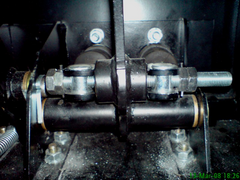propperly drilled and roll pinned.


Rescued attachment BiasBar.jpg

As i understand it, there is no requirement to actually lock the balance bar off, its just that the tester will want to test that the fronts lock
before the rears on both extrems of the balance bar...
seeing as im running 300mm front discs and standard sierra rears, i dont think there will ever be a point where the rears lock before the fronts...
therefore, do you think its worth me locking and pinning the bar? Or better to be safe than sorry?
just screw a locking nut onto the bar thread. tis what mine does and works fine
You must lock the movement of the balance bar with a roll-pin or similar for SVA.
My tester was pretty stringent on this point as I know others have been....!
My tester spent ages to check the rollpin was through that bar too and not just faked (i.e. half a rollpin through the nut only)...
If you have Sierra 9" drums it might surprise you how powerful they are at low speed.
At low hydraulic line pressure drum brakes self servo due to the leading show effect pulling the shoe into the drum.
Used to be a bit of a problem back in the days of Ford Anglias and the like the from drums had twin leading shows which would some times snatch with
a gentle application of the brakes was applied at slow speed.
The leading shoe effect is one of the reasons drum brakes always give a better handbrake efficiency than disks.
well, there seems to be alot of conflicting stories on this...
i have searched many threads on here, and consensus is that you dont need to lock the bias bar - you just need to make sure that at either end of
adjustment, the fronts lock first - most people nut and pin them to reduce the adjustment.
so im very confused.
i think ill stick a lock nut on each side, close to the clevis and put a pin through anyway.
I had a cover over the brake bias bar which prevented adjustment. It was rivetted in place and therefore the brake was "not adjustable"...
i am confused too! is it acceptable to use a nyloc nut along with original one and tighten both together?
No, you don't need to security-lock the adjustment as long as the rears don't lock first with the adjuster set for full rear bias.
(Obviously you should use some sort of lock-nut, Nyloc or double-nut, to prevent it adjusting itself!)
It's quite clearly stated in the SVA manual so I don't know why there is any confusion.
quote:
A vehicle that incorporates an adjustment device
(eg pedal linkage balance bar) that adjusts the
front/rear braking ratio (longitudinal brake
distribution) must be tested in the “worst case”
condition, ie maximum rear axle braking.
so does this mean i have to adjust the bias towards the rear before the sva?
quote:
Originally posted by saigonij
well, there seems to be alot of conflicting stories on this...
i have searched many threads on here, and consensus is that you dont need to lock the bias bar - you just need to make sure that at either end of adjustment, the fronts lock first - most people nut and pin them to reduce the adjustment.
so im very confused.
i think ill stick a lock nut on each side, close to the clevis and put a pin through anyway.
What it means is that the system will be tested in its worst possible position. If you don't lock the bias bar then it should be adjusted to give
the max possible pressure to the rears and then tested.
If hte rears lock first - it fails.
Hence people 'lock' the bias bar with a roll pin so that it can't be adjusted past a set position (ie the position that the brakes
work).
If you can't get at the bias bar to adjust it - then that's obviously its 'worst' position.
Although another way of looking at it is - do you really want to tamper with your brake safter passing SVA so you're doing 70mph with your rears
locked up trying to over take the fronts???
This is what i did in the end.
propperly drilled and roll pinned.


Rescued attachment BiasBar.jpg